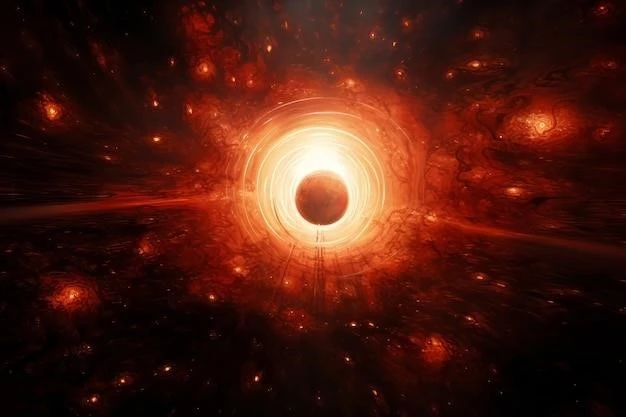Black holes‚ enigmatic cosmic entities‚ have captivated scientists and the public alike for decades․ Their immense gravitational pull‚ so strong that not even light can escape‚ makes them both fascinating and challenging to study․ This article delves into the world of black holes‚ exploring their basic properties‚ formation‚ and importance in astrophysics․ We discuss the singularity at their core‚ the event horizon that marks the point of no return‚ and the various ways in which black holes interact with their surroundings․

What is a Black Hole?
A black hole is not a hole in the traditional sense‚ but rather a region of spacetime where gravity is so powerful that nothing‚ not even light‚ can escape its grasp․ This extreme gravitational pull arises from the concentration of a massive amount of matter within an incredibly small space‚ resulting in an object of extraordinary density․
Formation of Black Holes
The most common way black holes form is through the death of massive stars․ When a star exhausts its nuclear fuel‚ it can no longer support itself against its own gravity․ The core collapses‚ and if the star is massive enough‚ this collapse continues indefinitely‚ forming a black hole․
Stellar-Mass Black Holes
Stellar-mass black holes form from the collapse of massive stars‚ typically those with masses greater than 20 times the mass of our Sun․ These black holes are relatively small‚ with radii of tens of kilometers‚ but incredibly dense․
Supermassive Black Holes
Supermassive black holes‚ as their name suggests‚ are giants lurking at the centers of most galaxies‚ including our own Milky Way․ These behemoths can have masses millions or even billions of times that of our Sun․ The exact mechanism of their formation remains an active area of research‚ but it is believed they grow by accreting matter from their surroundings and through mergers with other black holes․

Structure of a Black Hole
Singularity
At the heart of a black hole lies the singularity‚ a point of infinite density where the known laws of physics break down․ Here‚ all matter is crushed into a point of zero volume‚ and our current understanding of gravity and quantum mechanics is insufficient to describe the conditions․
Event Horizon
Surrounding the singularity is the event horizon‚ a boundary in spacetime beyond which escape from the black hole’s gravitational pull is impossible․ Anything that crosses the event horizon‚ whether it be matter or light‚ is inexorably drawn towards the singularity․
Observing the Unseen
Black holes‚ by their very nature‚ are invisible to direct observation․ However‚ their presence can be inferred through their interactions with surrounding matter․
Accretion Disks
As matter falls towards a black hole‚ it forms an accretion disk‚ a swirling disk of gas and dust that heats up and emits radiation across the electromagnetic spectrum․ These emissions can be detected by telescopes‚ providing evidence for the black hole’s existence․
Gravitational Waves
When black holes collide or merge‚ they create ripples in the fabric of spacetime known as gravitational waves․ These waves‚ predicted by Einstein’s theory of general relativity‚ can be detected by sensitive instruments on Earth‚ providing further evidence for the existence of black holes․
The Importance of Black Holes
Black holes‚ once considered mere theoretical curiosities‚ are now recognized as playing a crucial role in the evolution of galaxies and the universe as a whole․
Galaxy Formation and Evolution
The supermassive black holes at the centers of galaxies are believed to play a key role in the formation and evolution of their host galaxies․ The energy released as they accrete matter can regulate star formation and influence the dynamics of the entire galaxy․
Probing the Limits of Physics
Black holes provide a unique laboratory for testing the limits of our understanding of gravity and quantum mechanics․ The extreme conditions near the event horizon and singularity push these theories to their breaking point‚ offering insights into the fundamental nature of space‚ time‚ and matter․
Conclusion
Black holes remain some of the most enigmatic objects in the universe․ Their immense gravitational pull‚ ability to warp spacetime‚ and the mysteries surrounding their singularities continue to intrigue and inspire scientists․ As we develop new technologies and observational techniques‚ we can expect to unravel more of the secrets hidden within these cosmic behemoths‚ deepening our understanding of the universe and its fundamental laws․










